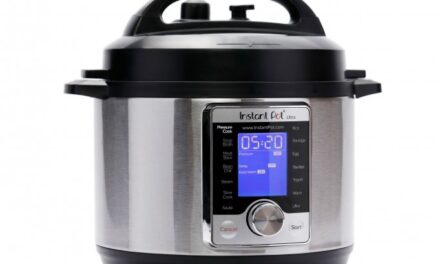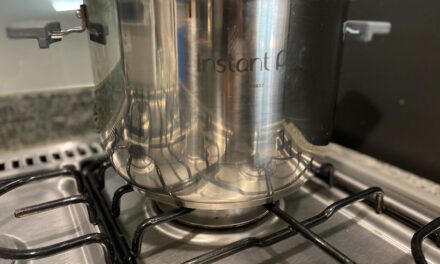Teflon is one of the most widely used non-stick coatings for cookware. But, not every brand uses it to coat their non-stick cookware, including Cuisinart.
Cuisinart coats their non-stick cookware with an enhanced version of Teflon called QuanTanium. Both Teflon and QuanTanium are PTFE-based, but QuanTanium is more durable and better prevents food from sticking to your cookware.
Does Cuisinart Use Teflon?
Cuisinart does not use Teflon on its non-stick cookware. Instead, they use a derivative of Teflon called QuanTanium.
QuanTanium is generally accepted as an improved form of Teflon. While QuanTanium does contain Teflon, it capitalizes on its effectiveness with additional components.
Cuisinart’s QuanTanium triple-coating is hard anodized for even more functionality.
Hard anodization promotes an even heating surface, reducing the chance of food sticking to your cookware.
What is QuanTanium?
Cuisinart’s QuanTanium is a PTFE-based coating that contains titanium alloys to add durability to non-stick cookware.
These titanium alloys strengthen the lifespan of the non-stick coating on your Cuisinart cookware by preventing sticking and scratching even more than Teflon does.
In addition to titanium, Cuisinart’s formula uses ceramic fragments to fortify the effectiveness of QuanTanium.
QuanTanium triple-coatings protect your Cuisinart cookware in the following ways:
- Prevents food from sticking
- Prevents scratches
- Increases the pan’s overall lifespan
Plus, the triple-coating gives the cookware a sleek look that ties your kitchen together when pans are left in plain view.
Why Does Cuisinart Use QuanTanium Instead of Teflon?
Cuisinart uses triple-coated QuanTanium instead of Teflon because the components are stronger and less prone to deterioration.
Food is more likely to stick to a basic Teflon coating than a QuanTanium-coated, hard anodized piece of Cuisinart cookware.
Cuisinart’s triple-coated QuanTanium cookware is solidified with strong layers, meaning your cookware will not quickly deteriorate from wear and tear.
Cuisinart cookware that contains QuanTanium or hard anodization provides a surface that allows food to cook evenly, takes away hotspots in certain areas of your cookware, and lengthens the life of your cookware.
Is QuanTanium Safe for Cookware?
When you choose cookware that contains an unusual mixture as a non-stick coating, you likely question its safety.
QuanTanium is safe for use on non-stick cookware. However, it does contain polytetrafluorethylene, or PTFE, which is also the main component of Teflon.
Although PTFE is generally considered safe, some worry about its potential toxicity.
Both Teflon and QuanTanium are safe to use, but QuanTanium has added components that strengthen the coating and enhance the non-stick performance of your cookware.
With a brand as prominent as Cuisinart, you can rest assured knowing their products are tested for safety.
This is especially true for Cuisinart’s cookware that contains hard anodized QuanTanium.
Is Teflon Safe for Cookware?
Teflon and QuanTanium are both PTFE-based coatings. Although some people are concerned about this material, PTFE is non-toxic to the extent used in cookware.
Still, poorly-coated products can become damaged more easily.
Teflon is generally regarded as a safe non-stick coating. However, a thin layer of Teflon can deteriorate over time, which can pose a health hazard if PTFE seeps into your food.
PTFE is not toxic, but it is also not meant for consumption.
If a Teflon coating breaks apart on your cookware, there is a potential for you to ingest PTFE if the broken coating goes to your food.
If Teflon particles get into your food while cooking, it strays from its intended purpose. Ingesting Teflon is not necessarily dangerous, but it’s best to avoid this scenario.
Are All Cuisinart Products Coated with QuanTanium?
Not all Cuisinart products contain a triple-coating of QuanTanium.
If you are looking for a pan that contains a QuanTanium coating, look for one or more of these descriptions on the packaging:
- Non-stick
- QuanTanium
- Hard anodized construction
- QuanTanium non-stick cooking surface
This material is exclusively used in Cuisinart’s non-stick cookware.
Does All Non-Stick Cuisinart Cookware Contain PTFE?
Some people worry about the potential toxicity of PTFE, a big component of Teflon and QuanTanium.
If having this chemical on your non-stick cookware concerns you, there is another option — Ceramica.
While most non-stick Cuisinart cookware contains QuanTanium, their Ceramica non-stick cookware does not.
Unlike QuanTanium and Teflon, Exclusive Cuisinart Ceramica is both PTFE and PFOA-free.
This type of cookware is a good choice for anyone who prefers to go the extra mile in terms of cookware safety.





